HI Lykkers! Let's explore the timeless charm of the Netherlands through its iconic windmills, which not only symbolize Dutch heritage but also play a pivotal role in the nation's history and current environmental sustainability efforts.
A Glimpse into History
Windmills in the Netherlands date back to the 8th century, initially used for milling grain.
The 14th century saw their evolution into tools for land drainage, crucial for a country that reclaimed much of its land from the sea. Today, these structures stand as majestic markers of Dutch innovation in water management.
Architectural Marvels
Dutch windmills are engineering masterpieces designed to harness the wind's power. Their robust wooden structures and thatched roofs are meticulously maintained, preserving the craftsmanship of bygone eras. Each windmill serves as a live museum, offering insights into the architectural styles that have withstood the test of time.
Cultural Significance
Beyond their practical use, windmills are a profound cultural symbol in the Netherlands. They represent the Dutch spirit of resilience and ingenuity, evident in the way these structures have been cherished and upheld through centuries. Many windmills are still operational, primarily maintained by passionate millers, often volunteers, who ensure their legacy continues.
Sustainable Icons
Amid modern environmental challenges, these historical windmills remind us of early sustainable practices. They are emblematic of the shift towards renewable energy sources, making them relevant even in today's eco-conscious world. The Netherlands continues to lead in innovative environmental solutions, with its traditional windmills standing as early pioneers of sustainability.
Visiting the Windmills
For travelers keen on experiencing Dutch culture firsthand, visiting these windmills offers a unique peek into the country's rich history and environmental ethos. Regions like Kinderdijk, with its cluster of 19 windmills, offer guided tours that detail the mechanics and history of these fascinating structures
Entrance Fees and Tours
Visiting windmills in the Netherlands can range from free to around €8 per adult, depending on the location and whether the windmill is part of a museum or park. For instance, the Kinderdijk UNESCO World Heritage site, one of the most famous windmill areas in the Netherlands, charges an entrance fee that includes access to the visitor center, a film about the windmill's history, and entrance to two museum windmills.
The Dutch windmill is more than just a structure; it is a journey through time, a testament to human ingenuity, and a beacon of sustainability. As guardians of history and harbingers of future environmental solutions, these windmills continue to spin stories as captivating as the landscapes they grace.


